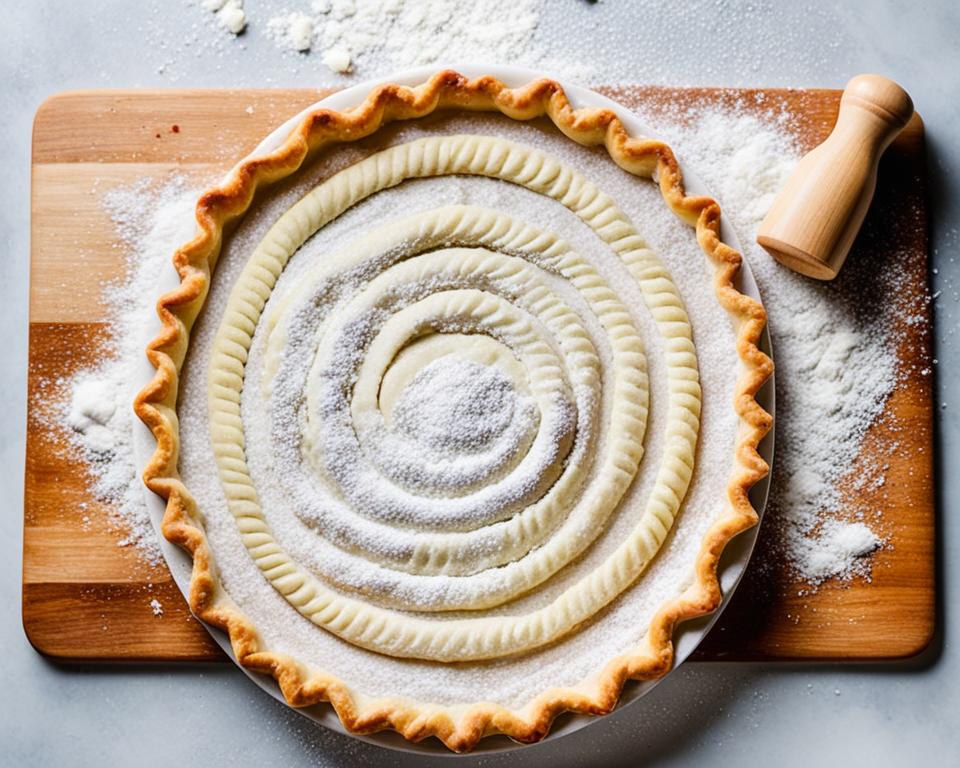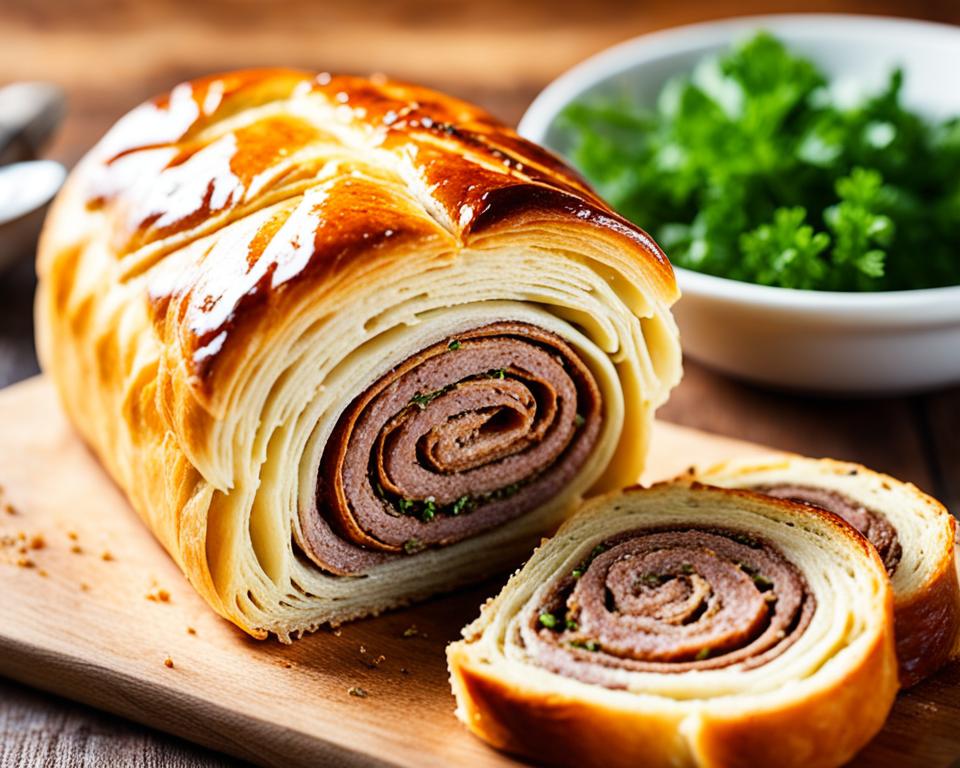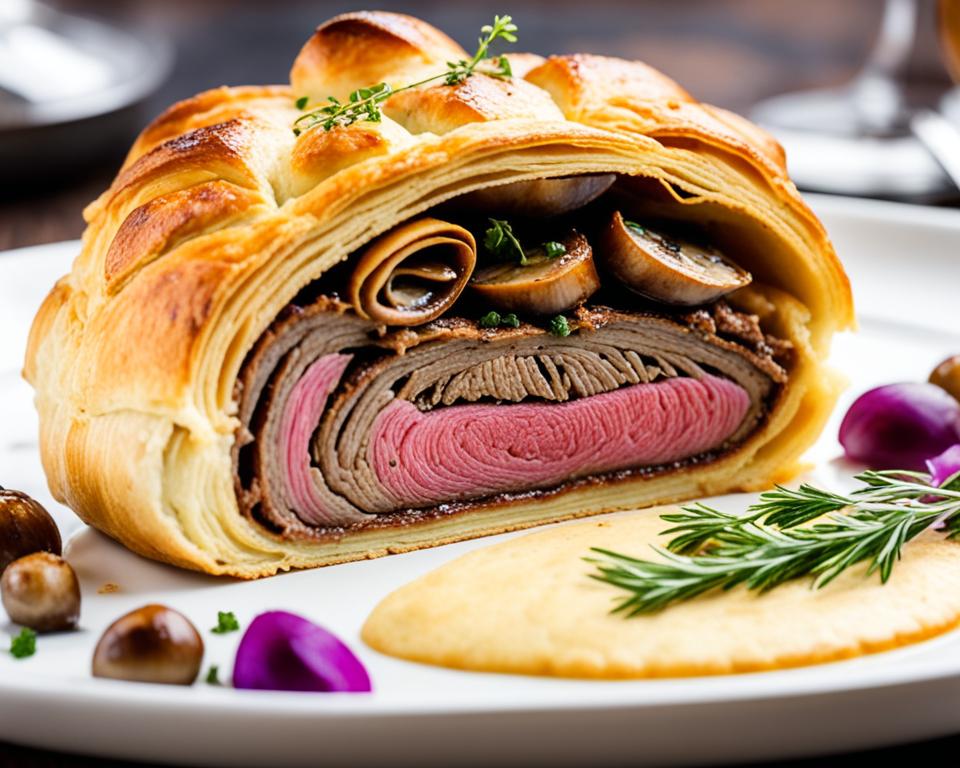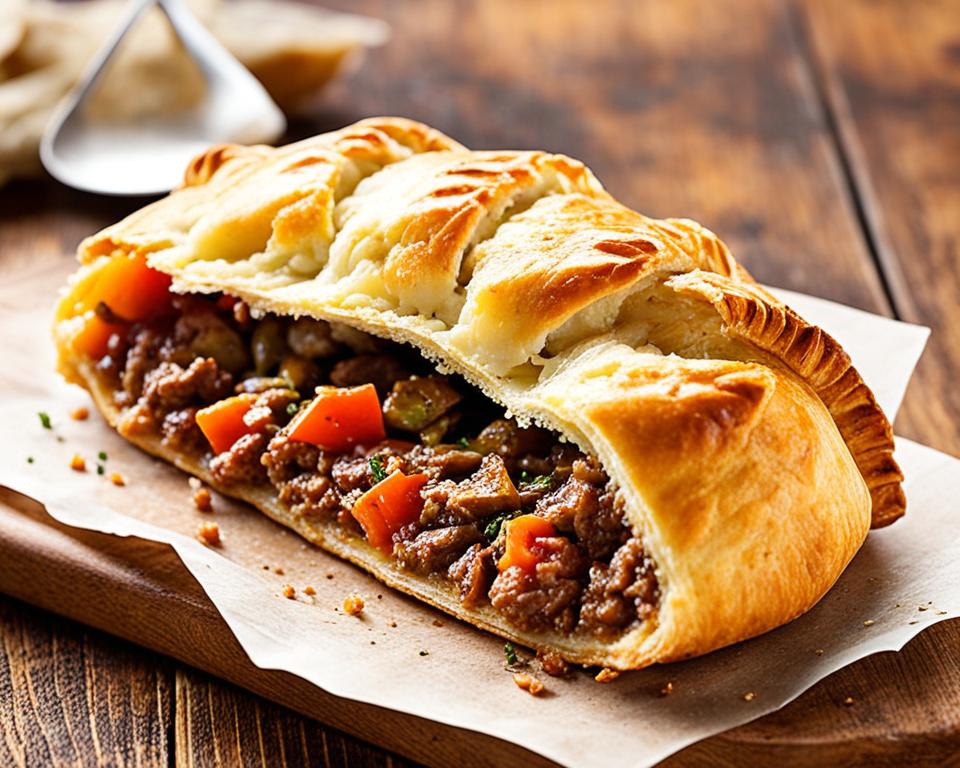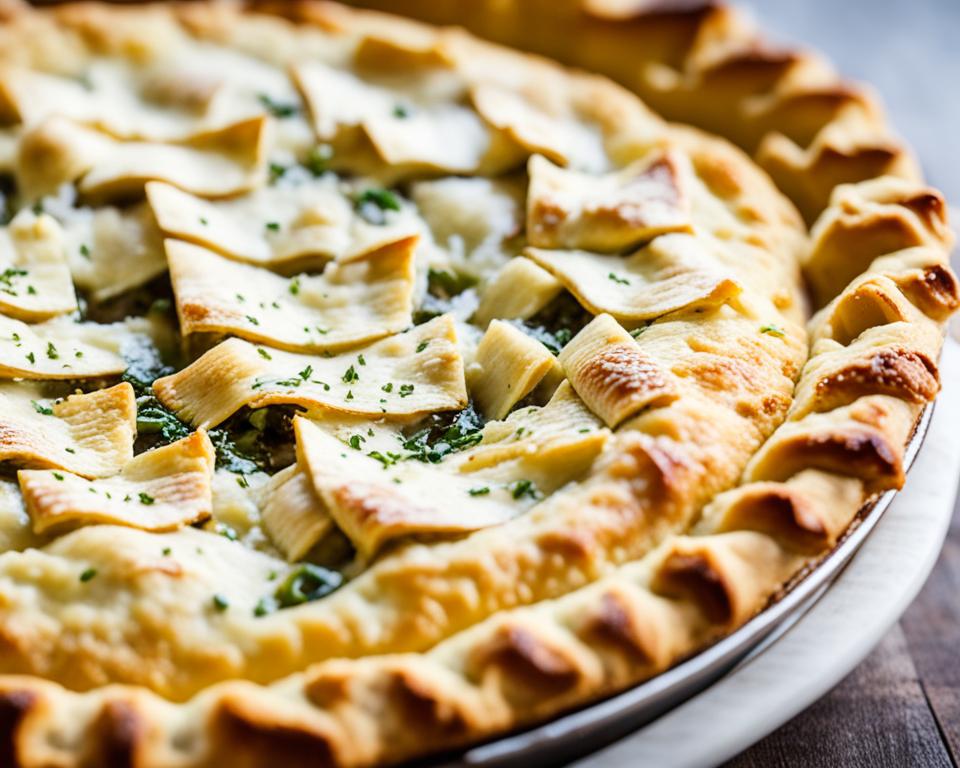Learn how to make a perfectly buttery, flaky pie crust from scratch using this in-depth tutorial and video. This recipe has been used by millions of readers since 2015 and is a foolproof way to achieve bakery-worthy results. With step-by-step photos and detailed instructions, you’ll be able to create buttery and delicious pastries every time.
Key Takeaways
- Creating homemade flaky pastry dough is worth the effort for superior flavor, texture, and appearance.
- Key ingredients for flaky pastry dough include all-purpose flour, salt, butter, vegetable shortening, and ice water.
- Mix and chill the dough to enhance flakiness and texture.
- Roll out the dough with gentle yet even pressure to avoid a tough crust.
- Keeping all ingredients cold is crucial for a flaky and tender pie crust.
Why Homemade Pie Crust?
While making a pie from scratch may seem time-consuming and intimidating, there are many reasons why homemade pie crust is worth the effort. Pies made with homemade flaky pastry have a superior flavor, texture, and appearance compared to store-bought crusts. By mastering the art of making flaky pastry dough, you’ll have the foundation for a variety of delicious desserts and savory pies.
When you take the time to make your own pie crust, you have complete control over the ingredients. You can choose high-quality butter, freshly milled flour, and premium shortening to ensure the best flavor and texture in your crust. Plus, homemade pastry gives you the freedom to experiment with different flavors and variations, adding a personal touch to your pies.
Not only does homemade flaky pastry taste better, but it also has a unique texture that is hard to achieve with store-bought crusts. The layers of butter and shortening in homemade crusts create a delicate, flaky texture that melts in your mouth with every bite. This contrast of crispness and tenderness elevates the overall pie-eating experience.
“Homemade pie crusts have a superior flavor, texture, and appearance compared to store-bought crusts.”
Additionally, homemade pie crusts tend to have a more appealing appearance. The golden, buttery crust with its delicate flakiness is simply irresistible. It adds visual appeal to your pies and makes them even more enticing to eat. Whether you’re serving a pie at a family gathering or taking it to a potluck, a homemade crust will always impress.
Besides, making your own flaky pastry dough can be a fun and rewarding experience. It’s a chance to express your creativity in the kitchen and enjoy the process of baking from scratch. The aroma of a freshly baked pie and the satisfaction of knowing you made it from start to finish is truly gratifying.
Unleash Your Inner Baker
If you’re ready to take your baking skills to the next level, learning how to make homemade flaky pastry is a great place to start. With a reliable recipe and some practice, you’ll be able to create pies that rival those from your favorite bakery. So, put on your apron, gather your ingredients, and embark on a delicious journey of homemade pie crust mastery.
Ingredients for Flaky Pie Crust
The key to a flaky pie crust lies in using the right ingredients. To create the best flaky pastry dough, you’ll need the following:
- All-purpose flour
- Salt
- Butter
- Vegetable shortening
- Ice water
Using high-quality flour, such as King Arthur Unbleached All-Purpose Flour, ensures a fluffier and fresher crust.
The combination of butter and shortening gives the crust its flakiness, while the ice water helps bring the dough together.
Flaky Pie Crust Ingredients
| Ingredients | Quantity |
|---|---|
| All-purpose flour | 2 ½ cups |
| Salt | 1 teaspoon |
| Butter, cold and unsalted | ½ cup (1 stick) |
| Vegetable shortening, cold | ½ cup |
| Ice water | 6-8 tablespoons |
Remember, using the right ingredients is crucial to achieving the flakiest pie crust possible.
Mixing and Chilling the Dough
To make the perfect flaky pastry dough, it’s important to handle the ingredients with care and keep them cold. Start by mixing the dry ingredients together in a large bowl, then cut in the butter and shortening using a pastry cutter or forks. Slowly add the ice water until the dough starts to come together.
Divide the dough in half and shape it into two discs. Wrap the discs tightly in plastic wrap and refrigerate for at least 2 hours to allow the gluten to relax and the fats to firm up.
Step-by-Step Instructions:
- Mix the dry ingredients in a large bowl.
- Add the butter and shortening, cut them in until crumbly.
- Slowly add the ice water while stirring, until the dough comes together.
- Divide the dough into two equal portions.
- Shape each portion into a disc shape.
- Wrap the discs tightly in plastic wrap.
- Refrigerate for at least 2 hours.
| Ingredients | Measurements |
|---|---|
| All-purpose flour | 2 ½ cups |
| Salt | 1 teaspoon |
| Butter (cold, unsalted) | 1 cup (2 sticks) |
| Vegetable shortening (cold) | ½ cup |
| Ice water | 4-6 tablespoons |
Rolling Out the Dough
Now that your flaky pastry dough has chilled, it’s time to roll it out and bring your pie crust to life. Rolling out the dough is a crucial step in achieving a perfectly flaky and tender crust. Follow these simple steps for success:
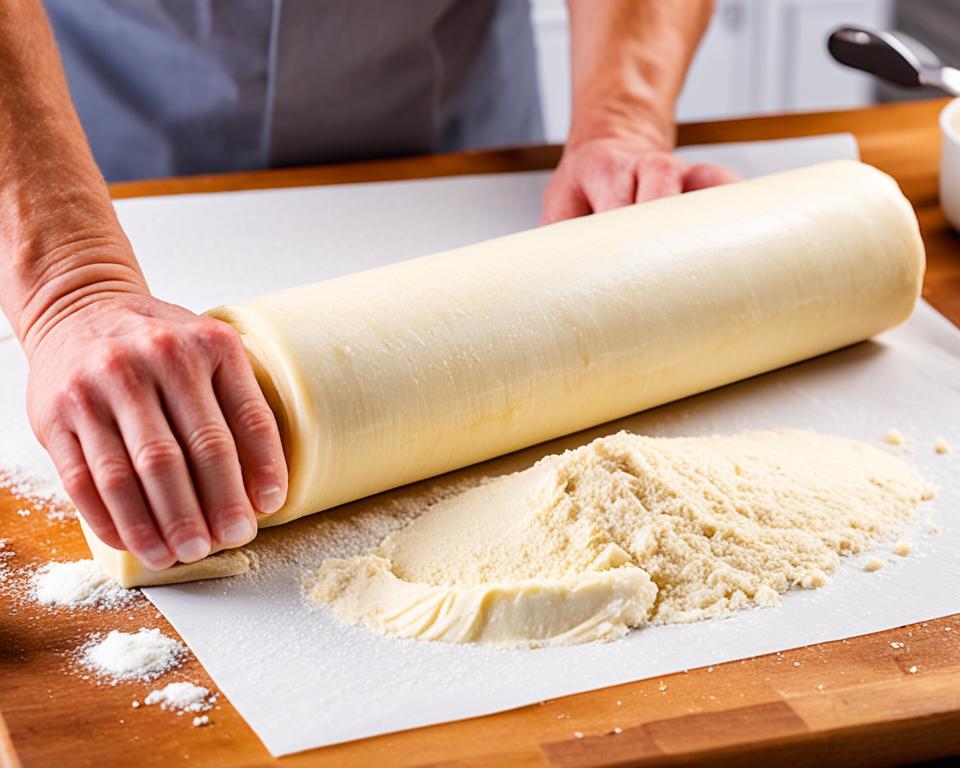
- Lightly flour your work surface to prevent the dough from sticking.
- Dust your rolling pin and the dough with flour.
- Gently roll the dough from the center outwards, using even pressure.
- Rotate the dough occasionally to maintain an even thickness.
- Aim for a 12-inch diameter if you’re using a 9-inch pie pan.
- Remember to be gentle and avoid overworking the dough, as this can result in a tough crust.
By rolling out the dough carefully, you’ll ensure that it bakes evenly and produces those beautiful flaky layers that everyone loves. Take your time and enjoy the process of bringing your pie crust to perfection!
Tips for a Flaky Pie Crust
Achieving a flaky pie crust requires attention to detail and some key tips. One important tip is to keep all the ingredients cold, including the butter, shortening, and water. The cold fats help create layers in the dough, resulting in a flakier crust.
Additionally, be sure to rest the dough in the refrigerator for at least 2 hours before rolling it out. This allows the gluten to relax and the fats to firm up, resulting in a tender and flaky crust.
Follow these tips to ensure your flaky pastry dough turns out perfectly every time:
- Use cold ingredients: Chilled butter and shortening are essential for a flaky crust. Cut them into small pieces and keep them in the refrigerator until ready to use.
- Chill the water: Measure out ice-cold water and refrigerate it before adding it to the dough. Cold water helps prevent the fats from melting and ensures proper texture.
- Handle the dough gently: Overworking the dough can lead to a tough crust. Mix the dough just enough to bring it together, and avoid kneading or stretching it excessively.
- Roll with care: When rolling out the dough, use a light touch and roll from the center outwards. Rotate the dough as you go to maintain an even thickness.
| Tip | Description |
|---|---|
| Keep ingredients cold | Chilled butter, shortening, and water create the perfect conditions for flaky layers in the crust. |
| Rest the dough | Refrigerating the dough allows the gluten to relax and the fats to firm up, resulting in a tender and flaky crust. |
Remember, practice makes perfect when it comes to making a foolproof flaky pie crust. With these tips in your arsenal, you’ll be well on your way to creating bakery-worthy pastries that will impress anyone lucky enough to enjoy them.
Freezing and Storing Pie Dough
If you want to make pie crust ahead of time, it’s easy to freeze and store the dough. After shaping the dough into discs, wrap them tightly in plastic wrap and place them in the freezer. The dough can be stored for up to 3 months. When you’re ready to use it, thaw it overnight in the refrigerator before rolling it out. This saves time and allows you to have homemade pie crust whenever you need it.
Freezing and storing pie dough is a convenient way to prepare in advance and have homemade flaky pastry at your fingertips. Whether you’re planning for a special occasion or simply want to save time on busy days, freezing pie dough ensures that you’re always ready to bake a delicious pie.
Here’s how you can freeze and store your pie dough:
- Shape the dough into discs: Once you’ve made the flaky pastry dough from scratch, divide it in half and shape each half into a flat disc.
- Wrap in plastic wrap: Individually wrap each disc tightly in plastic wrap. This helps prevent freezer burn and keeps the dough fresh.
- Label and date: Use a marker or label to clearly identify the type of dough and date it was frozen. This way, you can easily identify and use the oldest dough first.
- Place in the freezer: Put the wrapped dough discs in a freezer-safe bag or container. Make sure to remove as much air as possible to prevent freezer burn.
When you’re ready to use the frozen pie dough, follow these steps:
- Thaw overnight in the refrigerator: Take the wrapped dough disc out of the freezer and place it in the refrigerator overnight. This allows the dough to thaw slowly, ensuring it retains its moisture.
- Roll out the dough: Once thawed, lightly flour your work surface and roll the dough out to the desired thickness and size needed for your recipe.
- Use as directed: Follow your recipe’s instructions for baking with the thawed pie dough.
Freezing and storing pie dough is a great way to save time and have homemade flaky pastry readily available. Whether you’re a busy baker or want to plan ahead for special occasions, this method allows you to enjoy the convenience of homemade pie crust whenever you need it.
Troubleshooting Pie Crust Issues
While making pie crust is relatively straightforward, it’s not uncommon to encounter some common issues. By following the recipe carefully and using the recommended techniques, you can troubleshoot and prevent these issues.
Shrinking or Losing Shape
If your crust shrinks or loses its shape during baking, it may need more time to rest in the refrigerator. Ensure that you’ve allowed the dough to chill for at least 2 hours before rolling it out. This resting time allows the gluten to relax and the fats to firm up, resulting in a more stable crust. Additionally, be gentle when handling the dough during rolling and transferring to the pie pan to minimize any stretching or pulling that can cause shrinkage.
Tough Crust
If your crust becomes tough, it may be due to overworking the dough or adding too much water. When mixing the dough, be careful not to overmix or knead it excessively. Overworking the dough can develop the gluten, resulting in a tougher texture. Add the ice water gradually, using only as much as needed to bring the dough together. Avoid adding excess water, as this can make the crust dense and tough.
“The secret ingredient is always love.”
– Unknown
Remember that practice makes perfect, and troubleshooting pie crust issues is part of the learning process. Don’t be discouraged if you encounter challenges along the way. With patience and persistence, you’ll be able to achieve a homemade flaky pastry that will delight your taste buds and impress your loved ones.
| Common Pie Crust Issues | Troubleshooting Tips |
|---|---|
| Shrinking or losing shape | Allow the dough to rest in the refrigerator for at least 2 hours before rolling it out. Be gentle when handling the dough to minimize stretching. |
| Tough crust | Avoid overworking the dough and adding too much water. Mix the dough until just combined and add water gradually. |
By addressing these common issues and following the tips provided, you’ll be able to troubleshoot and overcome any challenges that may arise when making a homemade flaky pastry. With a little patience and practice, you’ll master the art of creating buttery and flaky pie crusts that will elevate your baking skills to new heights.
Using Homemade Flaky Pastry Dough
The beauty of having homemade flaky pastry dough is the versatility it offers. You can use the dough for a traditional pie, but it can also be used for mini pies, fruit galettes, hand pies, and even homemade pop tarts. The buttery and flaky texture of the dough enhances the overall taste and presentation of any dessert or savory dish.
| Dish | Description |
|---|---|
| Traditional Pie | A classic dessert with endless filling possibilities. From apple to pumpkin, the flaky pastry crust adds a delicious touch to every slice. |
| Mini Pies | Perfect for individual servings or party treats, mini pies are an adorable way to enjoy your favorite flavors. |
| Fruit Galettes | A rustic and elegant dessert that showcases seasonal fruits. The flaky pastry dough forms the perfect base for the luscious fruit filling. |
| Hand Pies | Portable and convenient, hand pies are great for on-the-go snacking or packing in lunchboxes. The flaky pastry dough holds a variety of sweet or savory fillings. |
| Homemade Pop Tarts | A nostalgic treat that you can customize with your favorite fillings and toppings. The buttery and flaky dough elevates this childhood favorite. |
Whether you’re serving a classic pie, a bite-sized treat, or an elegant fruit galette, homemade flaky pastry dough will take your creations to the next level. The delicate layers and rich flavor will impress both your family and guests.
Tips for Working with Flaky Pastry Dough:
- Ensure your work surface is well-floured to prevent sticking.
- Handle the dough gently to maintain its flakiness.
- Chill the dough if it becomes too soft or difficult to handle.
- Experiment with different fillings to create your own unique pastries.
“Using homemade flaky pastry dough allows for endless creativity in the kitchen. From sweet to savory, the possibilities are truly delicious.”
The Importance of Temperature
Temperature plays a crucial role in the success of your pie crust. Keeping the ingredients as cold as possible helps prevent the fats from melting before the crust bakes. The butter and shortening need to remain solid to create those flaky layers. By chilling the ingredients, working quickly, and using cold water, you’ll achieve the perfect temperature balance for a flaky and tender crust.
Perfecting Your Pie Crust Skills
Making flaky pastry dough is a skill that can be perfected with practice. Don’t be discouraged if your first attempts are not as perfect as you hoped. With each batch, you’ll learn more about the dough’s consistency, rolling techniques, and oven temperatures. Take your time and enjoy the process of creating your own delicious and flaky pastries.
Experimenting with Consistency
One of the keys to mastering flaky pastry dough is finding the perfect consistency. As you mix the ingredients together, pay attention to the texture of the dough. It should come together easily and hold its shape when pressed, but it shouldn’t be too sticky or dry. If the dough feels too sticky, add a little more flour. If it feels too dry, add a splash of ice water.
Mastering Rolling Techniques
Rolling out pie dough requires finesse and patience. When rolling, use a gentle touch and apply even pressure to create an even thickness. Start from the center and roll outward, rotating the dough occasionally to maintain a circular shape. If the dough starts to stick, lightly flour the surface and rolling pin. Remember, practice makes perfect, so don’t worry if your first few attempts aren’t flawless.
“The secret to a tender, flaky pie crust lies in the way you handle the dough.”
Understanding Oven Temperatures
Oven temperatures can significantly impact the final result of your pastry. Too high of a temperature can cause the crust to brown too quickly, while a lower temperature may result in a soggy crust. Follow the recipe instructions for baking temperature, but also keep an eye on the crust as it bakes. Adjust the oven temperature if necessary to achieve that perfect golden color and flaky texture.
By practicing and paying attention to the dough’s consistency, mastering rolling techniques, and understanding the impact of oven temperatures, you’ll soon become an expert in making flaky pastry dough. Enjoy the process, and before you know it, you’ll be delighting your family and friends with your homemade, buttery creations.
Conclusion
By following this perfect flaky pastry dough recipe and incorporating the tips and techniques mentioned, you can achieve a buttery and flaky pie crust that will impress your family and friends. With practice and patience, you’ll become a pro at creating delicious homemade flaky pastry that rivals those from the bakery.
So step into your kitchen and enjoy the process of baking with easy flaky pastry dough. With each batch, you’ll perfect your rolling techniques, master the art of keeping the ingredients cold, and create a tender and flaky crust that will elevate your sweet and savory dishes. From traditional pies to mini pies, fruit galettes to hand pies, and even homemade pop tarts, the possibilities are endless with homemade flaky pastry.
Don’t be discouraged if your initial attempts are not as perfect as you hoped. Baking is a journey, and with each step, you’ll gain more confidence and expertise. So gather your ingredients, follow the instructions, and savor the joy of creating your own flaky pastry dough from scratch. Your taste buds will thank you!
FAQ
Why should I make a homemade pie crust instead of using store-bought?
Homemade pie crusts have a superior flavor, texture, and appearance compared to store-bought crusts. Plus, by making your own, you have control over the ingredients and can customize the crust to your liking.
What are the basic ingredients for flaky pastry dough?
The basic ingredients for flaky pastry dough include all-purpose flour, salt, butter, vegetable shortening, and ice water.
How do I mix and chill the dough?
Start by mixing the dry ingredients together, then cut in the butter and shortening. Slowly add the ice water until the dough comes together. Divide the dough, shape it into discs, and refrigerate for at least 2 hours.
How do I roll out the dough?
Lightly flour the work surface, rolling pin, and dough. Roll the dough from the center outwards, rotating as you go. Aim for a 12-inch diameter for a 9-inch pie pan.
What tips can you provide for a flaky pie crust?
Keep all the ingredients cold, including the fats and water. Rest the dough in the refrigerator before rolling it out to relax the gluten and firm up the fats.
Can I freeze and store the dough?
Yes, after shaping the dough into discs, wrap them tightly in plastic wrap and freeze. Thaw overnight in the refrigerator before using.
What can I do if I encounter issues with my pie crust?
If your crust shrinks, it may need more time to rest in the refrigerator. If it becomes tough, you may have overworked the dough or added too much water.
How can I use homemade flaky pastry dough?
You can use it for traditional pies, mini pies, fruit galettes, hand pies, and even homemade pop tarts.
Why is temperature important for a flaky pie crust?
Keeping the ingredients cold prevents the fats from melting before the crust bakes, resulting in flaky layers.
How can I perfect my pie crust skills?
Practice and patience are key. With each batch, you’ll learn more about the dough’s consistency, rolling techniques, and oven temperatures.

